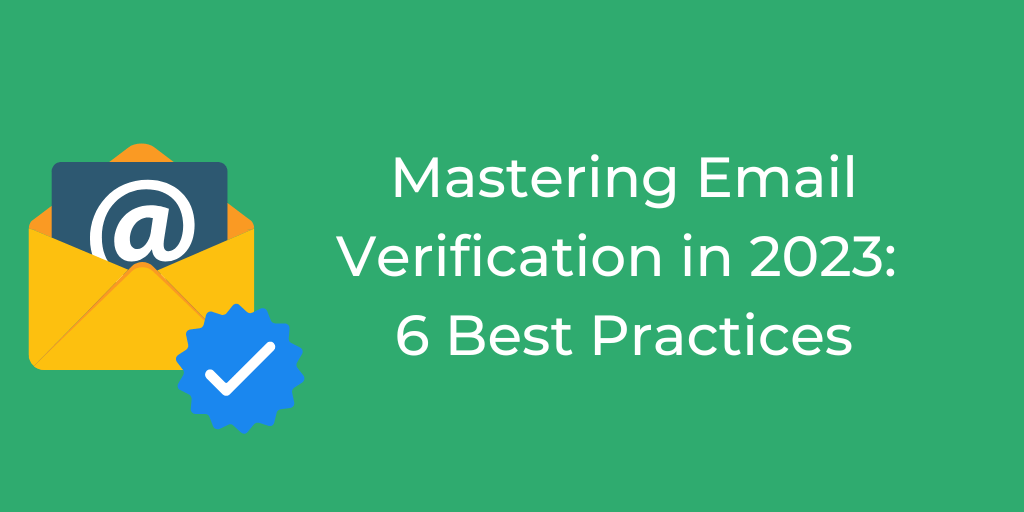Email verification is a vital process in the world of online communication. It ensures that your emails reach the intended recipients and helps maintain a positive sender reputation. In this comprehensive guide, we'll explore real-world email verification examples and best practices to help you improve your email deliverability and overall communication effectiveness.
Why Email Verification Matters
Before diving into specific email verification examples, let's understand why this process is crucial in today's digital landscape:
1. Reduce Bounce Rates:
- Email verification helps reduce bounce rates by ensuring that emails are sent to active and deliverable addresses. This, in turn, improves your sender reputation.
2. Improve Engagement:
- Validating email addresses ensures that your messages reach real recipients who are more likely to engage with your emails, resulting in higher open and click-through rates.
3. Prevent Fraud:
- Email verification helps prevent fraudulent registrations, sign-ups, and transactions by verifying the authenticity of email addresses provided by users.
4. Cost Efficiency:
- Sending emails to invalid or non-existent addresses wastes resources and can result in additional charges from your email service provider.
Real-World Email Verification Examples
Let's explore some real-world email verification examples to understand how this process works:
1. Verification During Sign-Up:
When a user signs up for an online service or platform, they are often required to provide an email address. The platform can use email verification to ensure that the provided address is valid and reachable.
Example: After a user signs up, they receive a verification email with a link. Clicking the link confirms that the provided email address is valid, and the user can access the platform's features.
2. Verification for Password Reset:
When a user forgets their password and requests a reset, email verification is often used to confirm the user's identity.
Example: The user receives an email with a link to reset their password. Clicking the link confirms that the user has access to the associated email account.
3. Double Opt-In for Subscriptions:
Email verification is commonly used for double opt-in subscriptions to email newsletters or marketing campaigns.
Example: After signing up for a newsletter, the user receives a confirmation email. Clicking a link in the email confirms their subscription.
4. Anti-Spam Measures:
Email verification can also be used as an anti-spam measure to prevent bots and malicious actors from flooding a system with fake email addresses.
Example: A website's contact form requires users to complete a CAPTCHA and confirm their email address before submitting inquiries.
5. E-commerce Order Confirmation:
In e-commerce, email verification ensures that customers receive order confirmations and updates.
Example: After placing an order, the customer receives an email confirmation with order details and a link to track the shipment.
Best Practices for Email Verification
Now that we've explored real-world email verification examples, let's discuss best practices to ensure the effectiveness of your email verification process:
1. Use Double Opt-In:
- Implement double opt-in procedures for subscriptions and registrations to confirm user intent and reduce the likelihood of fake or mistyped email addresses.
2. Regularly Clean Your Email List:
- Periodically validate and clean your email list to remove invalid or inactive addresses. This reduces bounce rates and improves deliverability.
3. Implement Real-Time Verification:
- Consider integrating real-time email verification into your sign-up and registration forms to prevent invalid addresses from entering your system.
4. Protect User Privacy:
- Handle email addresses with care and ensure they are not shared or used for purposes other than those explicitly stated during sign-up or registration.
5. Monitor Your Sender Reputation:
- Regularly check your sender reputation to maintain a positive image in the eyes of email service providers.
6. Test Your Verification Emails:
- Test the verification emails that you send to users to ensure they reach the inbox and are user-friendly.
Common Questions About Email Verification
Let's address some commonly asked questions related to email verification:
Q1: How do I choose an email verification service?
- A1: When selecting an email verification service, consider factors like accuracy, speed, cost, and ease of integration with your existing systems.
Q2: Can email verification services check if an email address is actively used?
- A2: Some email verification services offer the option to check if an email address has recent activity, but this may not always be foolproof.
Q3: Is it necessary to use email verification for every online sign-up?
- A3: While it's not mandatory for every sign-up, using email verification is a best practice to ensure the validity of email addresses and the authenticity of users.



